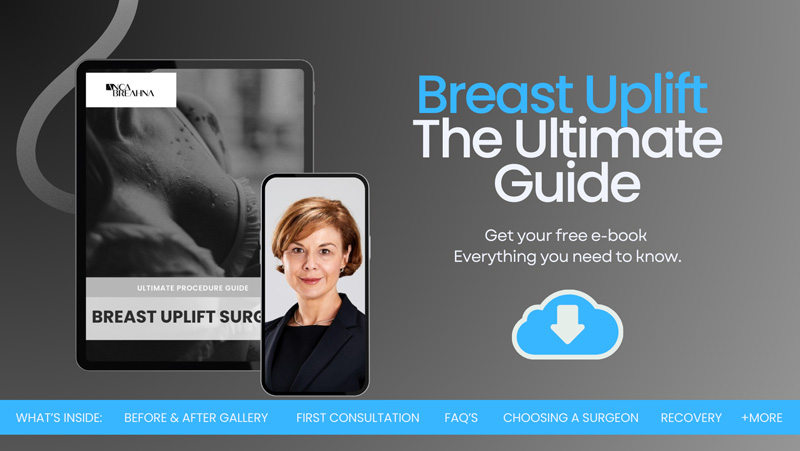
A New Bra Uplift Technique for Long-Lasting Results – Internal Bra
In the world of cosmetic surgery, breast uplift procedures have long been a popular method for addressing changes that often occur with age, after weight loss, or post-pregnancy. Typically, these traditional techniques involve removing excess skin and tightening the surrounding tissue to reshape and support the new breast contour. However, while effective initially, these methods come with their own set of challenges, prompting the need for innovations like the internal bra uplift technique.
Anca Breahna, PhD, MSc, FEBOPRAS, FRCS (Plast) is a distinguished Consultant Plastic Surgeon with expertise in Aesthetic and Reconstructive Plastic Surgery. She stands out as one of the few female Plastic Surgeons in her region, bringing a unique female perspective to her practice, characterised by empathy, meticulous attention to detail, and personalised care.
Download Miss Anca Breahna Breast Uplift Guide

What Is the Internal Bra Technique?
The internal bra procedure isn’t about just lifting the breast tissue but also securing it to prevent future sagging, which sets it apart from standard methods. Anca uses specially designed materials to construct supports within the breast. These supports act as ligaments to keep everything in place, providing a solution designed to last much longer than traditional methods.
This technique not only offers a lasting solution but also works to reduce the common complications associated with standard breast uplift procedures. With fewer incisions required, there’s less risk of noticeable scarring, issues with sensation, or asymmetry. The internal bra procedure is particularly noteworthy for those who have undergone previous breast surgeries and are seeking corrective procedures or a more permanent solution to sagging.
Breast Ptosis and Conventional Correction Methods
When discussing cosmetic breast surgery, it’s essential to start at the root of what many people seek to correct: breast ptosis. Simply put, breast ptosis refers to the drooping or sagging of the breasts. This change in the breast’s shape can be due to several factors, but regardless of the cause, it often leads to the same endpoint: the consideration of surgical intervention for a more desirable breast contour.
What Causes Breast Ptosis?
One of the most common causes is the natural ageing process. As you age, your skin loses some of its essential supports – collagen and elastin. This loss makes the skin less resilient and more prone to the effects of gravity, leading to a change in the shape of the breasts.
Furthermore, significant weight fluctuations can result in breast ptosis. When you gain weight, your skin stretches, and if you lose that weight, your skin might not shrink back entirely, leading to sagging. Similarly, pregnancy can bring about breast ptosis due to the expansion and contraction of the breast skin over a short period. It’s not just the process of childbirth; breastfeeding can also contribute to changes in breast shape and texture.
To understand more about the underlying causes and preventive measures, see How Do You Prevent Sagging Breasts? – What Causes Breasts to Sag.
Limitations and Challenges of Traditional Procedures
Traditional breast uplift surgeries come with their own set of complications and limitations. First, there are aesthetic concerns like scarring. Incisions, while strategically placed, still heal into scars. Depending on your body’s healing ability, these scars can be quite prominent, even if they fade over time.
Loss of sensation in the nipples or breasts is another issue, as nerve endings can be severed during surgery. For some, the sensation returns over time, but for others, it may be a permanent consequence. Asymmetry between the breasts is an additional risk, despite the surgeon’s best efforts to create symmetry.
Another significant concern is the longevity of the results. Traditional breast lifts offer no guarantee against future sagging, as the ageing process continues and life events such as pregnancy or weight changes can all lead to further ptosis. Consequently, some individuals find themselves needing revision surgeries in the future, facing additional recovery time and expense.
The internal bra technique has emerged in response to the limitations of traditional breast lift surgeries, offering a longer-lasting solution to breast ptosis while mitigating common post-operative challenges.
How Is the Internal Bra Lift Surgery Performed?
The concept of the internal bra system didn’t appear overnight. It was the result of years of progress in the field of cosmetic surgery, with specialists exploring alternative materials and techniques to provide more sustainable support to the breast tissue. The technique began to take shape as surgeons used various synthetic and biological materials to try and create an internal structure that could mimic the support traditionally provided by a bra.
This journey was driven by the need to improve patient outcomes, reduce the frequency of revision surgeries, and provide a stable, long-term solution for breast support. The development phase underwent several iterations, refining the procedure to ensure safety and optimise results, before finally introducing the technique to a wider audience in the realm of cosmetic surgery.
So, what does the internal bra procedure entail, and what materials are at play? The operation involves Anca creating a supportive “sling” or “bra” inside your breasts. This is achieved using specialised medical materials, such as surgical mesh or silk threads, known for their strength and compatibility with the human body.
During the procedure, Anca places this mesh or threads underneath the breast tissue or muscles, securing it to your chest wall. The material cradles the breast, providing upward and inward support reminiscent of how a traditional bra works. This not only lifts the breast to a more desirable position but also helps maintain that position over time, thanks to the durable nature of the materials used.
At the heart of the internal bra system’s success is the science of its construction materials. The surgical mesh or threads used are biocompatible, reducing the risk of the body rejecting them. They are also incredibly strong, resisting wear and tear, and providing a level of support that skin and natural breast tissue cannot maintain on their own.
Moreover, the internal bra isn’t just about providing immediate results. It’s designed for longevity, addressing one of the main drawbacks of traditional breast uplift procedures. The mesh or thread network within the breast encourages tissue ingrowth over time, with your body’s natural healing processes incorporating the artificial support into your biological system. This integration further solidifies the structure, ensuring it doesn’t shift or degrade as quickly as natural tissues might, offering a more permanent solution to sagging.
Internal Bra vs. Traditional Breast Uplift
When considering breast enhancement, understanding the differences between new techniques and traditional methods is key to making an informed decision. Here, we provide a comprehensive comparison between the internal bra procedure and conventional breast uplift surgery, highlighting various factors that typically influence decision-making in cosmetic surgery.
Surgical Time, Recovery, and Complication Rates
- Surgical Time: Traditional breast uplift surgery can take around two to three hours, depending on the extent of work needed. The internal bra procedure might extend this time slightly due to the additional steps involved in placing the supportive material. However, the extra time spent can be a worthwhile investment for longer-lasting results
- Recovery: Post-operative recovery times are similar in both procedures, with initial healing occurring over several weeks and full recovery taking a few months. With the internal bra, some patients report slightly more discomfort during the initial recovery phase due to the internal placement of the supportive material, but this is a subjective experience
- Complication Rates: Both procedures come with the general risks of surgery, such as infection or reaction to anaesthesia. Traditional methods might have higher rates of post-operative sagging, necessitating revision surgery. The internal bra procedure, while still relatively new, shows promise in reducing such long-term complications, thanks to the durable support it provides
Cost Implications
The financial aspect of surgery is often a deciding factor. Traditional breast uplift surgery has a standard cost range, which varies depending on geographical location, the plastic surgeon’s expertise, and facility fees. The internal bra system, due to the specialised materials and added surgical steps, can be more expensive upfront. However, considering it may reduce the need for future revision surgeries, the investment could be financially sound over time.
Candidacy and Personalised Approach
Not everyone will automatically be the perfect candidate. It’s vital to understand the specific factors that qualify someone for this procedure and to recognise the importance of a personalised approach in surgical plans.
Identifying the ideal candidate for the internal bra procedure involves a series of evaluations. Firstly, you must be in good health. Any significant medical conditions, particularly those affecting the heart or immune system, need to be stabilised; this is standard for any surgery to minimise risks during the operation and recovery.
Next, the degree of breast sagging is a determinant. Those with a moderate level of sagging benefit most from the internal bra system. If you have minimal sagging, traditional methods might be recommended, while extensive sagging might require more comprehensive procedures.
Your skin quality also plays a role. Good elasticity helps with the reshaping of the breast and healing post-surgery. If you have significantly stretched or thin skin, often due to ageing or sun damage, the surgeon might take extra precautions to ensure that the internal support system will be effective.
Lastly, realistic expectations are key. Understanding what the surgery can and cannot do is essential. The internal bra offers support and shape correction but doesn’t significantly change breast size, nor does it stop the natural ageing process.
FAQs about Internal Bra Lift Technique
What exactly is an internal bra procedure?
- The internal bra procedure is an advanced surgical technique used in breast uplift surgery, where durable materials like surgical mesh or silk threads are placed inside the breast. These materials act as a “bra” inside your chest, providing structural support and maintaining the breast’s position and shape over a more extended period than traditional methods.
How long does the recovery take after undergoing the internal bra procedure?
- Recovery times can vary based on individual factors, but generally, you may expect initial recovery to take several weeks, during which strenuous activities should be avoided. Full recovery and settling into the final shape could take a few months. It’s important to follow your plastic surgeon’s post-operative care instructions to ensure a smooth recovery process.
Are there any specific risks associated with the internal bra procedure?
- As with any surgery, the internal bra procedure comes with general surgical risks such as infection, bleeding, or adverse reactions to anaesthesia. Specific to this procedure, there may be risks of mesh-related complications, such as mesh erosion or infection, and issues with tissue integration. A thorough discussion with plastic your surgeon will help you understand these risks based on your health history and lifestyle.
Will the internal bra procedure prevent future breast sagging?
- The internal bra technique is designed to provide longer-lasting support to the breasts, reducing the extent of future sagging. It’s important to note that no surgical procedure can halt the natural ageing process, and factors such as significant weight fluctuations, pregnancy, or changes in skin elasticity can affect the longevity of your results.
How do I know if the internal bra procedure is the right choice for me?
- Choosing the internal bra procedure depends on several factors, including your overall health, the degree of breast sagging, skin quality, and expectations from the surgery. A consultation with Anca is essential. She will evaluate your suitability for the procedure and discuss potential outcomes and any alternatives that might be better suited to your individual case.
Further Reading about Breast Lift Surgery with Consultant Plastic Surgeon Anca Breahna
- Read more about Solutions for Saggy Breasts
- Read more about Solutions for Uneven Breasts
- Read more about Breast Uplift – Mastopexy
- Read more about Breast Implant Removal and Uplift
- Read more about Excess Skin after Weight Loss – Causes and Solutions
- Read more about When Can I Exercise After Breast Uplift Surgery?
- Read more about Top 10 Strategies to Reduce Bruising After Breast Uplift Surgery
Medical References about Breast Surgery Techniques
- What You Need to Know About Breast Augmentation – Medical News Today
- Types of Breast Surgery for Cancer, Cosmetic & Preventative – Cleveland Clinic
- Breast Enlargement (Implants) – NHS
- A Rationale for Prophylactic Internal Bra Support in Breast Augmentation– PubMed


 Ms Anca Breahna, PhD, MSc, FEBOPRAS, FRCS (Plast) is a highly regarded Consultant Plastic Surgeon specialising in the field of Aesthetic and Reconstructive Plastic Surgery. Anca performs a range of
Ms Anca Breahna, PhD, MSc, FEBOPRAS, FRCS (Plast) is a highly regarded Consultant Plastic Surgeon specialising in the field of Aesthetic and Reconstructive Plastic Surgery. Anca performs a range of 